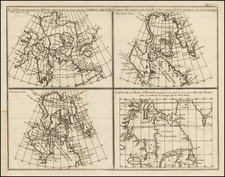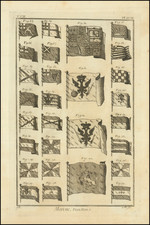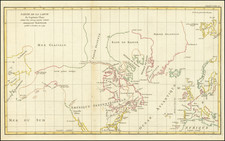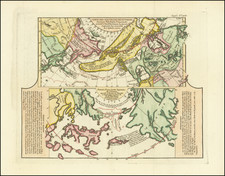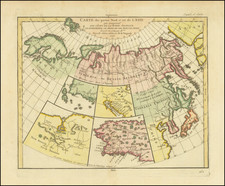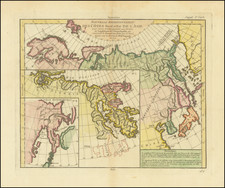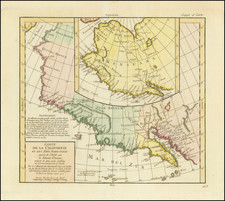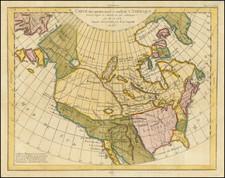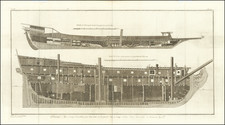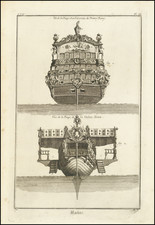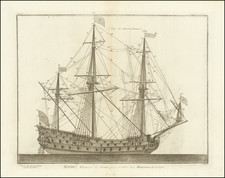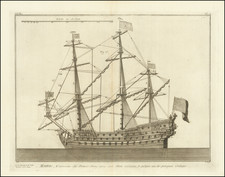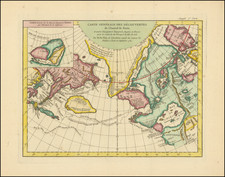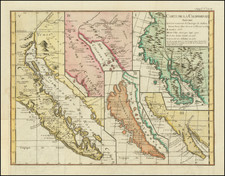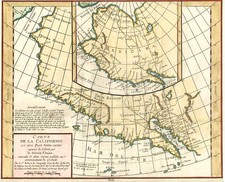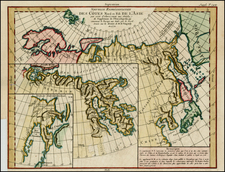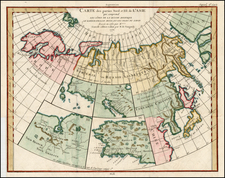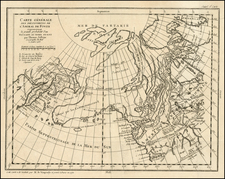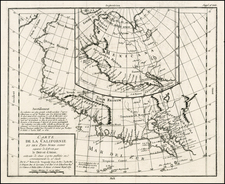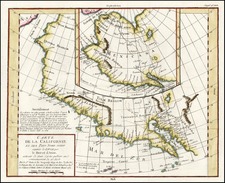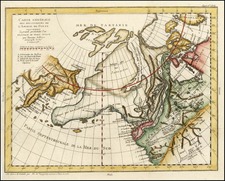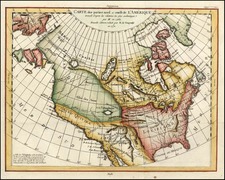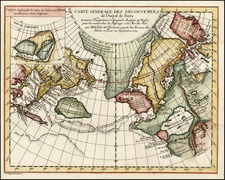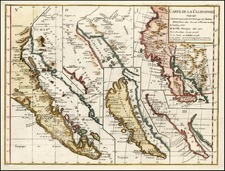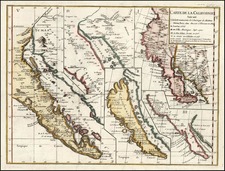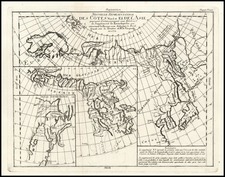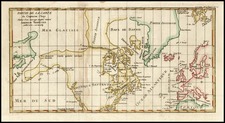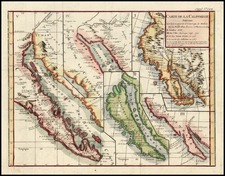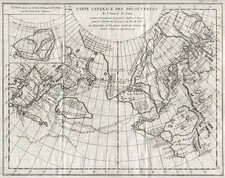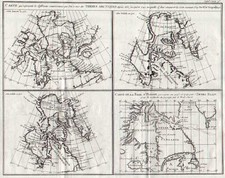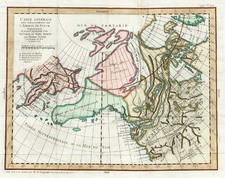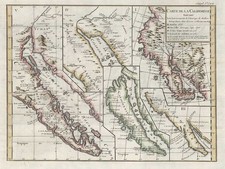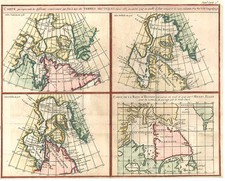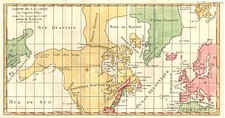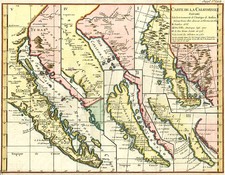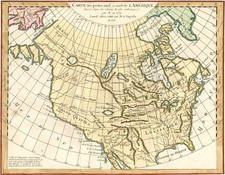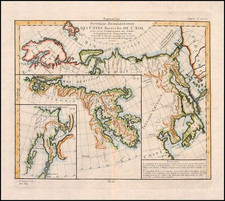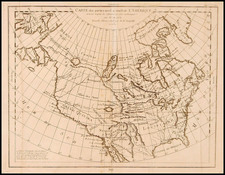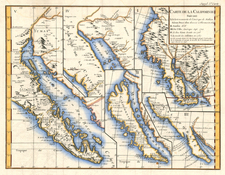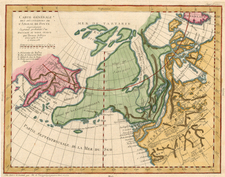Denis Diderot’s Encyclopedie is one of the landmark’s of modern thought. Completed in 1772, it represented the single greatest democratization of knowledge and is without question one of the most important printed works of all time. As part of his Encyclopedie, Diderot undertook a study of the cartography of Western America, the Northwest Coast of America and the Northeast Coast of Asia, consolidating the numerous and disparate reports and maps of a number of different mapmakers and explorers of the period and providing a work of tremendous interest for its presentation as work of comparative cartography at a time when it was far from certain which of the competing theories was most accurate. His maps tackle the difficult questions faced by mapmakers of the era how to reconcile the information obtained from French, Russian, Spanish, English, Japanese and ancient sources, including unproven geographical features such as the Northwest Passage and Bay of the West.
The series of maps includes the now famous study of the 5 different representations of the mapping of California. Perhaps most fascinating is that while Diderot was assiduously condensing the known cartographic content of the region, Captain James Cook was in the process of undertaking the voyages which would completely re-write the cartography of the region covered by Diderot’s maps. Prepared by the famous French map maker Didier Robert de Vaugondy, the maps provide a fascinating snapshot of perhaps the greatest cartographic debate of the second half of the 18th Century.
Diderot’s 10 maps provide a fascinating historical review of the cartography of André Le Breton, a bookseller and printer, initially approached Diderot with a project to translate Ephraim Chambers' Cyclopaedia, or Universal Dictionary of Arts and Sciences into French. During the translation, Diderot envisioned a grander project. He persuaded Le Breton to help sponsor a new work, which would collect all the active writers, ideas, and knowledge that were moving the cultivated class of the Republic of Letters, but which was not well disseminated. Le Breton agreed and Jean le Rond d'Alembert was recruited to collaborate on the work.
In 1750, an elaborate prospectus announced the project and in 1751 the first volume was published. This work was very unorthodox and had many forward thinking ideas for the time. Diderot stated within this work, "An encyclopedia ought to make good the failure to execute such a project hitherto, and should encompass not only the fields already covered by the academies, but each and every branch of human knowledge." Upon encompassing every branch of knowledge this will give, "the power to change men's common way of thinking." This idea was profound and intriguing, as it was one of the first works during the Enlightenment. Diderot wanted to give all people the ability to further their knowledge and, in a sense, allow every person to have any knowledge they sought of the world.
Diderot’s Encyclopedie sought to bring together all knowledge of the time and condense such information for all to use, using not only the expertise of scholars and Academies in their respective fields but that of the common man in their proficiencies in their trades. These people would amalgamate and work under a society to perform such a project. They would work alone in order to shed societal conformities, and build a multitude of information on a desired subject with varying view points, methods, or philosophies. All people would benefit from these insights into different subjects as a means of betterment; bettering society as a whole and individuals alike.
Diderot’s vision was in fact antithetical to the French monarchy, as it would severely dilute the regime's ability to control the people. Knowledge and power, two key items the upper class held over the lower class, were in jeopardy as knowledge would be more accessible, giving way to more power amongst the lower class. An encyclopedia would give the layman an ability to reason and use knowledge to better themselves; allowing for upward mobility and increased intellectual abundance amongst the lower class. A growth of knowledge amongst this segment of society would provide power to this group and a yearning to question the government. The monarchy did not see any benefit in the works, instead viewing them as a threat to the power and authority of the monarchy.
Diderot's work was plagued by controversy from the beginning. It was suspended by the courts in 1752, as accusations arose, regarding seditious content, concerning the editors entries on religion and natural law. Diderot was detained and his house was searched for manuscripts for subsequent articles. But the search proved fruitless as no manuscripts could be found. They were hidden in the house of an unlikely confederate – Chretien de Lamoignon Malesherbes, the very official who ordered the search. Although Malesherbis was a staunch absolutist-loyal to the monarchy, he was sympathetic to the literary project. Along with his support, and that of other well placed influential confederates, the project resumed.
For twenty years, Diderot was harassed, persecuted and frequently abandoned by his friends. The church detested the Encyclopédie, which embodied a rising stronghold for their philosophic enemies. By 1757, the subscribers had grown from 2,000 to 4,000, a measure of the growth of the work in popular influence and power. The Encyclopédie threatened the governing social classes of France because it took for granted the justice of religious tolerance, freedom of thought, and the value of science and industry. It asserted the doctrine that the main concern of the nation's government ought to be the nation's common people. It was believed that the Encyclopédie was the work of an organized band of conspirators against society, and that the dangerous ideas they held were made truly formidable by their open publication.
In 1759, the Encyclopédie was formally suppressed. The decree did not stop the work, but did successed in forcing its publishers to operate in a more clandestine fashion. D'Alembert withdrew from the enterprise and others, including Anne Robert Jacques Turgot, Baron de Laune, declined to contribute further. Diderot was left to finish the task as best he could. He wrote several hundred articles, some very slight, but many of them laborious, comprehensive, and long. He damaged his eyesight correcting proofs and editing the manuscripts of less competent contributors. He was constantly harassed by threats of police raids.
The last copies of the first volume were issued in 1765. Even in its completion, Diderot suffered the indignation of learning that the bookseller, fearing the government's displeasure, had struck out from the proof sheets, after they had left Diderot's hands, all passages that he considered too dangerous. The monument to which Diderot had given the labor of twenty long and oppressive years was irreparably mutilated and defaced. The final 27 folio volumes of the Encyclopédie, ou dictionnaire raisonné des sciences, des arts et des métiers were not completed until 1772.

